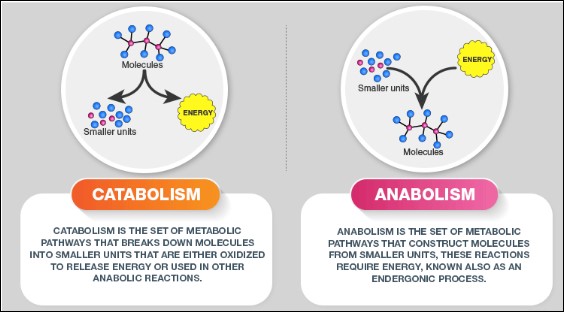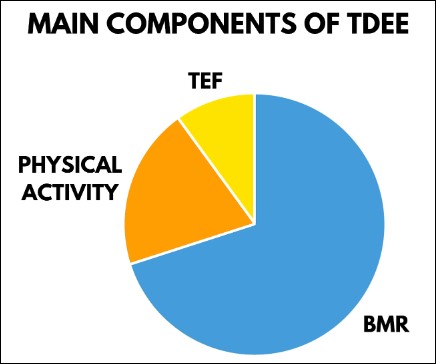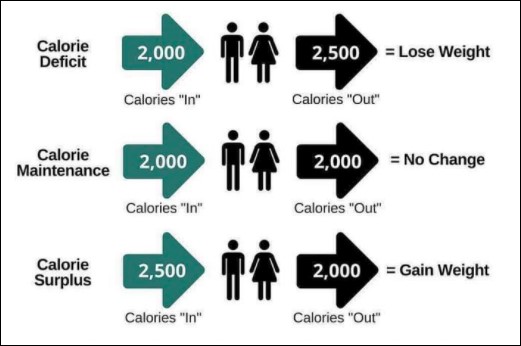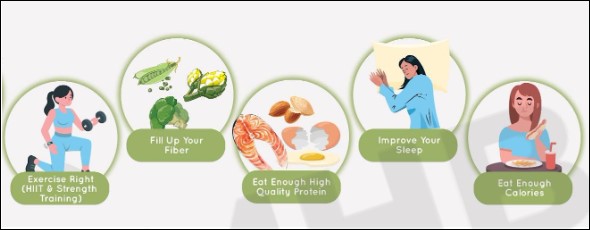Introduction
A common statement we often hear from people not losing weight is “My metabolism is slow” or “Mai saans lu to bhi mera wajan badh jaata hai.” (I gain weight even if I breathe air).
Whenever weight management or nutrition comes up in conversation, terms like “metabolism” and “TDEE” often arise. But what do these terms mean, and how do they relate to our daily lives? In this Blog, we’ll break down the complexities of metabolism, explore the Total Daily Energy Expenditure (TDEE) concept, and share tips on boosting metabolic rate.
What is Metabolism?
At its core, metabolism refers to all the chemical reactions in the body to maintain life. The human body comprises chemicals: Enzymes, hormones, nutrients, food, fluids, blood, and DNA. To grasp the complexities of metabolism, it is crucial to understand its two primary processes: anabolism and catabolism. Together, these pathways constitute cellular metabolic reactions, enabling the body to maintain life, grow, repair tissues, and respond to its environment.
- Anabolism: Anabolism is the constructive phase of metabolism in which the body cells synthesize protoplasm for their growth and repair.
Example:
- Bone growth and mineralization.
- Muscle mass increases through protein synthesis.
- Storing excess glucose as glycogen in the liver and muscles.
- Catabolism: Catabolism is the destructive phase of metabolism where larger molecules are broken down into smaller ones, releasing energy.
Example:
- The breakdown of glucose during glycolysis produces energy in the form of ATP.
- The breakdown of fats in fatty acid oxidation produces energy.
- The degradation of proteins into amino acids.IntroductionA common statement we often hear from people not losing weight is “My metabolism is slow” or “Mai saans lu to bhi mera wajan badh jaata hai.” (I gain weight even if I breathe air). Whenever weight management or nutrition comes up in conversation, terms like “metabolism” and “TDEE” often arise. But what do these terms mean, and how do they relate to our daily lives? In this Blog, we’ll break down the complexities of metabolism, explore the Total Daily Energy Expenditure (TDEE) concept, and share tips on boosting metabolic rate.What is Metabolism?
At its core, metabolism refers to all the chemical reactions in the body to maintain life. The human body comprises chemicals: Enzymes, hormones, nutrients, food, fluids, blood, and DNA. To grasp the complexities of metabolism, it is crucial to understand its two primary processes: anabolism and catabolism. Together, these pathways constitute cellular metabolic reactions, enabling the body to maintain life, grow, repair tissues, and respond to its environment.
- Anabolism: Anabolism is the constructive phase of metabolism in which the body cells synthesize protoplasm for their growth and repair.
Example:
- Bone growth and mineralization.
- Muscle mass increases through protein synthesis.
- Storing excess glucose as glycogen in the liver and muscles.
- Catabolism: Catabolism is the destructive phase of metabolism where larger molecules are broken down into smaller ones, releasing energy.
Example:
- The breakdown of glucose during glycolysis produces energy in the form of ATP.
- The breakdown of fats in fatty acid oxidation produces energy.
- The degradation of proteins into amino acids.IntroductionA common statement we often hear from people not losing weight is “My metabolism is slow” or “Mai saans lu to bhi mera wajan badh jaata hai.” (I gain weight even if I breathe air). Whenever weight management or nutrition comes up in conversation, terms like “metabolism” and “TDEE” often arise. But what do these terms mean, and how do they relate to our daily lives? In this Blog, we’ll break down the complexities of metabolism, explore the Total Daily Energy Expenditure (TDEE) concept, and share tips on boosting metabolic rate.What is Metabolism?
At its core, metabolism refers to all the chemical reactions in the body to maintain life. The human body comprises chemicals: Enzymes, hormones, nutrients, food, fluids, blood, and DNA. To grasp the complexities of metabolism, it is crucial to understand its two primary processes: anabolism and catabolism. Together, these pathways constitute cellular metabolic reactions, enabling the body to maintain life, grow, repair tissues, and respond to its environment.
- Anabolism: Anabolism is the constructive phase of metabolism in which the body cells synthesize protoplasm for their growth and repair.
Example:
- Bone growth and mineralization.
- Muscle mass increases through protein synthesis.
- Storing excess glucose as glycogen in the liver and muscles.
- Catabolism: Catabolism is the destructive phase of metabolism where larger molecules are broken down into smaller ones, releasing energy.
Example:
- The breakdown of glucose during glycolysis produces energy in the form of ATP.
- The breakdown of fats in fatty acid oxidation produces energy.
- The degradation of proteins into amino acids

While anabolism and catabolism might seem like opposing forces, they are deeply interdependent and work in tandem to maintain a balance in the body, often described as metabolic homeostasis. The energy released from catabolic processes fuels anabolic ones, ensuring the body can grow, repair damage, and respond to its environment. This delicate dance of breaking down and building up is a constant activity underlying the very essence of life. The rate at which these reactions occur determines how efficiently we burn energy, known as the metabolic rate.
Relation between Metabolism, Activity Levels ((Total Daily Energy Expenditure (TDEE)) and weight management.
TDEE is the sum of all the energy or calories your body expends daily. It’s calculated by adding your BMR, the calories burned through physical activity, and the TEF.

TDEE= Basal Metabolic Rate (BMR) + TOTAL ACTIVITY(NEAT+EAT) + Thermic Effect of Food (TEF)
- Basal Metabolic Rate (BMR): This accounts for about 60-75% of the calories we burn daily. It represents the energy expended at rest equivalent to when a person is comatose to maintain essential physiological functions such as breathing, blood flow, organs working, cell production, and body temperature regulation.
- Physical Activity: This varies greatly among individuals. Someone with a desk job will burn fewer calories from physical activity compared to an athlete in training. They are divided into:
- NEAT (Non-Exercise Activity Thermogenesis): Notice the words ‘non-exercise’ -Overlooked yet essential. It refers to the calories burned from movements not part of a structured workout. This includes rising from bed, going to the kitchen for breakfast, hurrying to catch a bus, and strolling to the office elevator. It’s all the seemingly insignificant motions or the fidgeting we do throughout the day.
- EAT (Exercise Activity Thermogenesis): The calories we burn while doing a planned activity include walking, running, swimming, and going to the gym.
- Thermic Effect of Food (TEF): Calories burned during the digestion and absorption of nutrients from food is termed the Thermic Effect of Food. Some foods necessitate more energy for digestion, which is why there are often articles touting ‘foods that boost metabolism.’ However, these foods don’t precisely “boost” metabolism in the traditional sense. Instead, they require more energy to digest. Protein is a prime example of this category. The body expends more energy to metabolize proteins, so many health experts recommend a protein-rich diet when trying to shed Kilos. It ranges anywhere from 10-20 %. A mixed meal that comprises Carbs, fat and protein can use up to 25% of the total calories consumed.
Knowing your TDEE can be instrumental in weight management. TDEE is the upper limit of the calories that we can consume. BMR is the lower limit. Weight loss will happen if we eat anything between these two ranges.
Example:
Mr Raj weighs 70 Kgs. He has an active lifestyle. His BMR comes up to 1500 calories, and his TDEE is 2000.
Now, he must eat between 1,500 and 1900 calories to lose weight. If he wants to lose weight faster because he has some vacation plans, we can start from 1500 calories, i.e., TDEE – 500 cals, but that increases the rate of muscle loss. If he wants to lose weight sustainably without missing out on social events, he can create a smaller deficit and diet at 1800 calories.
To gain weight, he should eat calories beyond TDEE, i.e. TDEE + 200-500 cals. This will mean extra available calories, which can be used to build muscles along with well-planned workouts.
If he is happy with his current weight and lifestyle, he must consume 2000 calories daily to maintain the status quo.

To sum up:
If you eat less than your TDEE calories, you will lose weight.
If you eat equivalent to your TDEE calories, you maintain your current weight.
If you eat more than your TDEE calories, you will gain weight.
So, if this is taken care of, your weight will change, even if you think your metabolism is fast or slow.
How can one boost metabolism? Do superfoods boost them?
Everyone’s metabolic rate varies due to genetics, age, gender, and muscle mass. The idea of specific foods boosting your metabolism is overhyped to sell supplements or push certain foods to create demand. The hard-hitting fact is that no food can boost your metabolism. It can boost your metabolic rate at the max, but that, too, is temporary and short-term. Examples are cinnamon, ginger, and cayenne pepper. Talking about the bright side, there are ways to give your metabolism a nudge/ prevent its slowdown:

- Increase Muscle Mass: Muscle tissues burn more calories than fat tissues, even at rest. Resistance training or weight lifting can help increase muscle mass, a fat-burning furnace. Free weights, resistance bands, and gym machines can aid this process. It’s also essential to progressively increase the weight or resistance over time to continue muscle growth.
- Stay Active: Cardiovascular exercises burn calories during the activity and induce an “afterburn” effect known as Excess Post-exercise Oxygen Consumption (EPOC). This effect means your body continues to burn calories at a higher rate even after the exercise. This could be steady-state exercises like running, cycling, or swimming. High-Intensity Interval Training (HIIT) can also be effective, where you alternate between high-intensity bursts and low-intensity recovery periods.
- Eat Protein-Rich Foods: Consuming protein has been shown to cause a significant increase in TEF, boosting metabolism by up to 30% for a few hours. It also helps with the maintenance and repair of muscles. Include protein-rich foods like lean meats (chicken, turkey, beef), fish, eggs, dairy products, legumes, and plant-based proteins like tofu and tempeh. Aim to incorporate a protein source in each meal.
- Get Adequate Sleep: Sleep is essential for overall health and hormonal balance. Lack of sleep can disrupt the hormonal balance that regulates appetite, energy expenditure, and glucose metabolism, negatively impacting your metabolic rate. Prioritise 7-9 hours of sleep for adults. Ensure a sleep-conducive environment – dark, quiet, and cool. Avoid screen time and caffeine before bedtime and maintain a consistent sleep schedule.
- Avoid Crash Diets: Drastically reducing calorie intake can send your body into a “starvation mode,” where it conserves energy, decreasing BMR. Furthermore, crash diets often result in muscle loss, further decreasing metabolic rate. Instead of drastic calorie reductions, aim for a moderate calorie deficit if weight loss is your goal. Ensure you are eating enough to fuel your body and maintain muscle mass.
Certain foods may help slightly increase your metabolic rate or how many calories you burn. However, these foods will not negate a high-calorie or poor-quality diet.
People worry a lot about slow metabolism but don’t do the basic things needed for fat loss. A deficit/Surplus, eating well-balanced meals, avoiding binge eating on weekends, being active, sleeping and staying hydrated consistently will help them rev up their metabolism. So, fix the basics and watch yourself transform.





